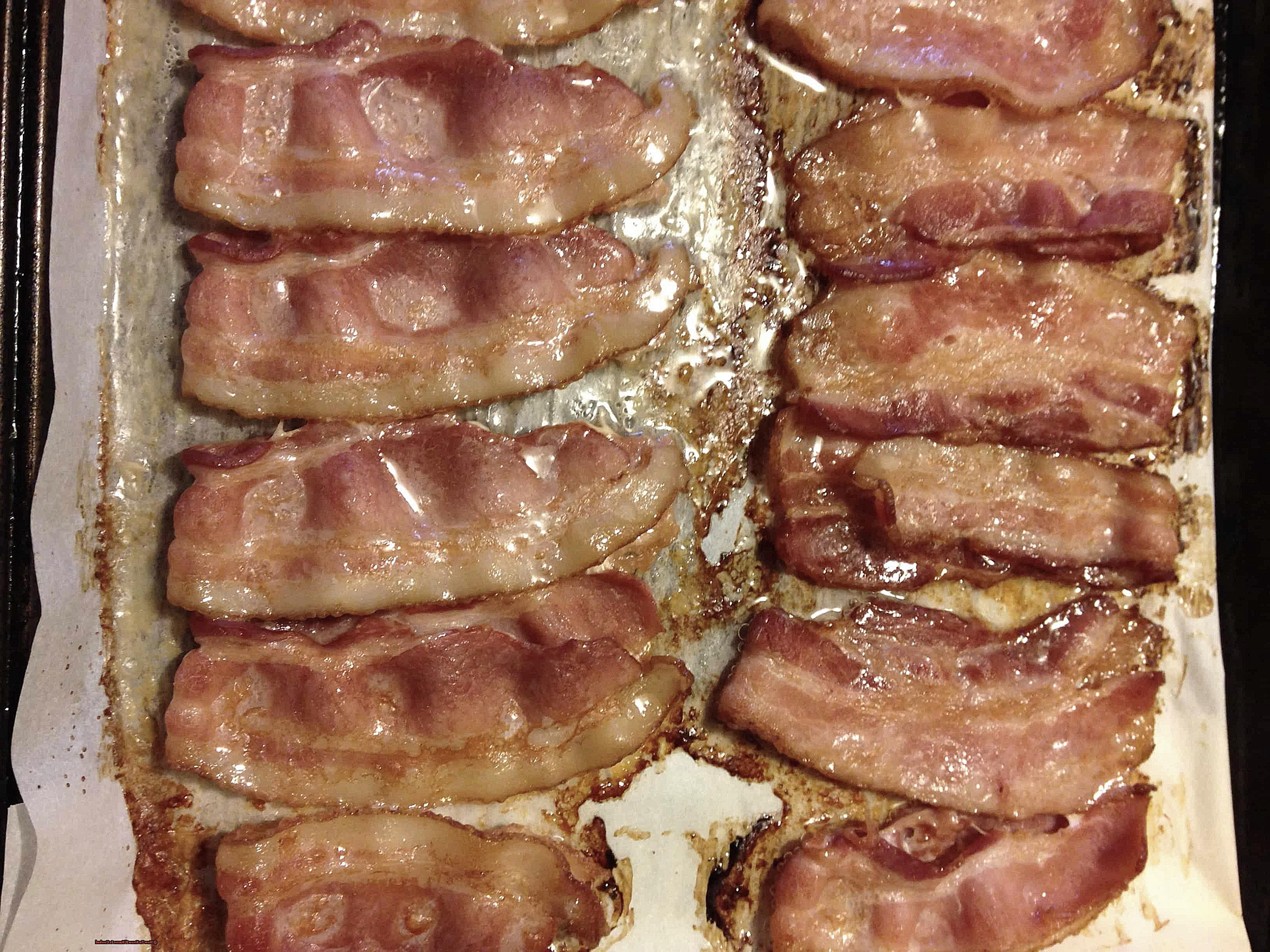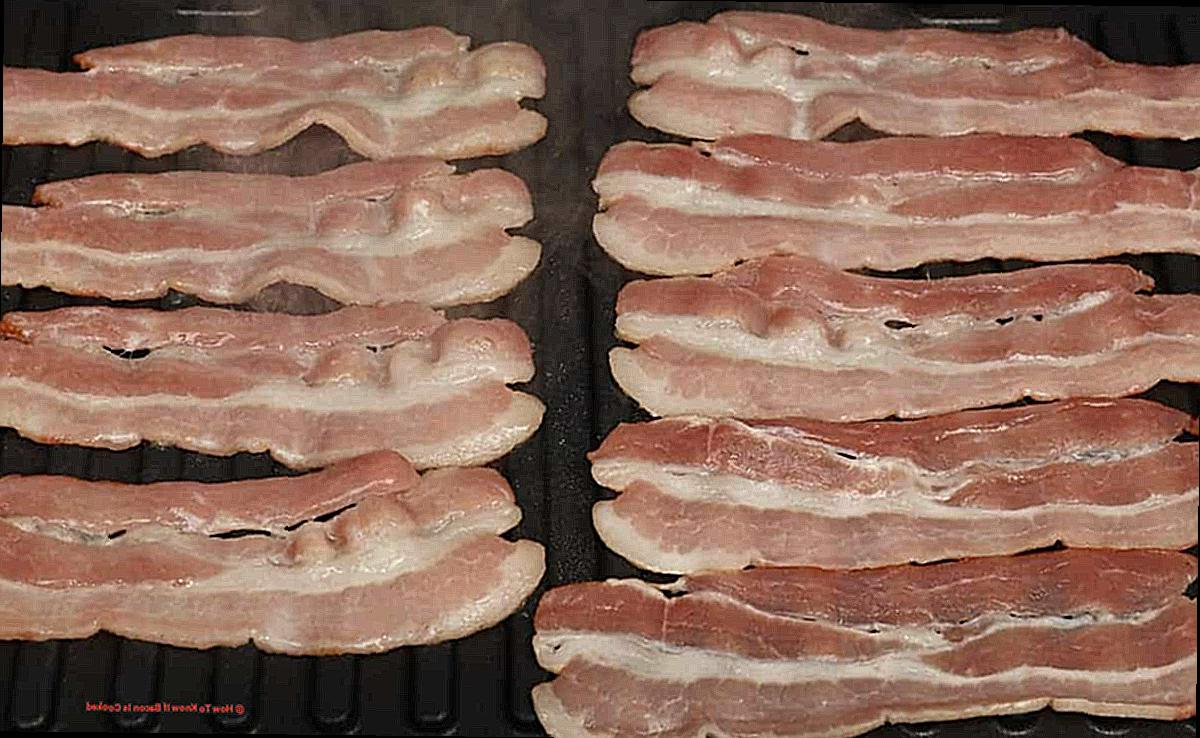Are you a bacon lover like me? The irresistible smell, the crispy texture, and the savory taste – it’s no wonder why bacon is a breakfast staple. But have you ever been unsure if your bacon is cooked just right? Don’t worry, my fellow bacon enthusiasts, I’m here to help. Let’s dive into some easy-to-follow tips on how to tell if your bacon is perfectly cooked.
- Look for a golden brown color: The first sign of well-cooked bacon is its beautiful golden hue. As it sizzles in the pan, keep an eye on the color. Once it turns golden brown, it’s usually ready.
- Check the texture: Bacon should be crispy on the outside and slightly chewy on the inside. To test this, gently press down on it with tongs or a fork. If it feels firm and breaks easily, then you’re on the right track.
- Listen for sizzling: As bacon cooks, it releases fat which causes that satisfying sizzle in the pan. When the sound starts to decrease, that means most of the fat has rendered out and your bacon is likely close to being done.
- Use a thermometer: For those who prefer precision, an instant-read thermometer can be helpful. Insert it into the thickest part of your bacon and check for a temperature between 145°F and 150°F.
- Trust your instincts (or nose): Sometimes our senses are our best guides. If your gut tells you that your bacon looks and smells deliciously cooked, then go ahead and take it off the heat.
Now armed with these simple tricks, you can confidently cook perfect batches of bacon every time. No more guessing or risking overcooked or undercooked strips – just pure bacon perfection.
Contents
How To Tell If Bacon Is Cooked?
Before you indulge in a delicious bacon breakfast, it’s important to make sure it’s fully cooked and safe to eat. Luckily, there are several key indicators you can look for to ensure your bacon is cooked to perfection and ready for consumption.
Texture:
When it comes to texture, properly cooked bacon should be crispy and firm, not limp or soggy. Achieving this perfect texture requires cooking your bacon low and slow in a cast iron or non-stick pan. This method allows for even cooking and crispiness without the risk of becoming too hard or burnt.
Color:
As your bacon cooks, you’ll notice a change in color from pink to a light golden brown, or darker depending on your personal preference. If the bacon is still pink, it’s not fully cooked and needs a bit more time on the heat. On the other hand, if it’s dark brown or burnt, it may have been overcooked and could be tough and dry.

Shape:
Keep an eye on the edges of your bacon as it cooks. As it shrinks and releases fat, the corners and edges will naturally curl up, indicating that it’s becoming crispy. If the edges are still straight, give your bacon a little more time to cook.
Moisture:
Another important factor to consider is the moisture content of your bacon. After cooking, most of the grease should be drained or soaked up with paper towels, leaving minimal moisture behind. If there is still excess grease in the pan or on the bacon itself, it may need to cook a bit longer.
To ensure optimal results every time, remember to cook your bacon low and slow and pour off excess fat between batches to prevent steaming and maintain that perfect crispiness.
How Long Does It Take For Bacon To Cook
On average, it takes around 10 minutes to cook bacon on the stove. However, the cooking time may differ depending on the thickness of the bacon and your desired level of crispiness. To ensure that bacon is cooked properly, there are a few important things to consider.
- CRISPINESS: The first indication that bacon is cooked properly is its crispiness. A well-cooked strip of bacon should be crispy and snappy, not chewy or rubbery.
- COLOR: Another crucial factor to keep in mind is the color of the bacon. Fully cooked bacon should have a golden brown hue, with no raw or pink areas.
- SHAPE: Bacon should also have a consistent shape when fully cooked. If the edges are uneven or curled, it may still need more time on the stove.
- MOISTURE LEVELS: Lastly, check the moisture levels of the bacon. When fully cooked, bacon should not be greasy or slimy.
| TYPE OF BACON | COOKING TIME | INTERNAL TEMPERATURE |
|---|---|---|
| Fine-cut Bacon | 5-7 minutes | 145°F (63°C) |
| Thick-cut Bacon | 10-12 minutes | 145°F (63°C) |
| Turkey Bacon | 5-7 minutes | 165°F (74°C) |
| Vegan Bacon | 3-5 minutes | N/A (differs by brand) |
As mentioned earlier, using a thermometer is the most accurate way to determine if bacon is cooked correctly. Insert the thermometer into the thickest part of the bacon, ensuring it does not touch the pan. Bacon should be cooked to an internal temperature of 145°F (63°C) for safe consumption.
If you do not have a thermometer, follow these general guidelines for cooking bacon:
- Fine-cut bacon: Cook for 5-7 minutes on each side at a temperature of 400°F (204°C).
- Thick-cut bacon: Cook for 10-12 minutes on each side at a temperature of 400°F (204°C).
- Turkey bacon: Cook for 5-7 minutes on each side at a temperature of 375°F (190°C).
- Vegan bacon: Cook for 3-5 minutes on each side at a temperature of 375°F (190°C).
It is important to note that cooking times may vary depending on the type and thickness of the bacon, as well as personal preference.
How To Make Sure The Bacon Is Cooked Perfectly
| Visual Indicators | Description |
| Color | The color changes from a pinkish-red to a brownish-red or golden-brown when bacon is cooked perfectly. To ensure the bacon is cooked perfectly, use a meat thermometer to check the internal temperature of the bacon, which should be between 145-160 degrees Fahrenheit. |
| Texture | Cooked bacon should have a crispy exterior and a slightly chewy interior. If it is too rubbery or chewy, it requires more cooking time. On the other hand, if it is overly crispy and brittle, it may have been overcooked, resulting in dry and tough bacon. |
Cooking Techniques:
- Begin in a Cold Pan – Starting bacon in a cold pan provides for even cooking without burning or becoming excessively crispy on the outside. This technique also allows the fat to render out gradually, creating crispy bacon.
- Bake in the Oven – Cooking bacon in the oven at 400 degrees Fahrenheit for 15-20 minutes ensures more controlled cooking and reduces the risk of burning or undercooking.
- Use a Cast-Iron Skillet – The consistent heat distribution of cast iron aids in cooking the bacon evenly while also imparting a delectable smoky flavor.
- Cook Slowly on Low Heat – Cook bacon on low heat to achieve crispiness without burning. Remove excess fat with a basting bulb or paper towels.
- Cook in Batches – Cooking too much bacon at once can result in steaming rather than frying. It’s preferable to cook in batches rather than overfilling the pan.
How To Make Sure The Bacon Is Cooked Perfectly
When preparing bacon, it is crucial to ensure it is cooked correctly for both safety and optimal taste. Here are some indicators to look for when checking for perfect bacon:
| Appearance | Properly cooked bacon should have a golden brown color, while raw bacon appears light pink. If the bacon is overcooked, it will be dark brown. |
| Texture | The ideal texture of cooked bacon is crispy, but not too dry. You can use a spoon or knife to feel its texture. |
| Grease | Cooked bacon should release a generous amount of grease, indicating that the fat has been rendered out. |
| Shape | Perfectly cooked bacon should have crimped edges, indicating that it has shrunk in size. |
By checking for these signs, you can ensure that your bacon is cooked perfectly and ready to be savored. It is important to monitor the color and texture throughout the cooking process to prevent overcooking or burning. Additionally, removing excess grease with a basting bulb or paper towels can help achieve the desired texture.
It is worth noting that everyone has their own preference for the texture of bacon. Some may prefer it extra crispy, while others enjoy it softer. Adjusting the cooking time and temperature can help achieve the perfect texture for your personal taste.
Conclusion
In summary, mastering the art of cooking bacon takes careful observation and a few key cues.
From its alluring golden hue and satisfying crunch to the delightful sizzle and rendered fat, these telltale signs are your guide to achieving bacon perfection. In addition, utilizing a thermometer or trusting your intuition can also aid in achieving the desired level of doneness.
So go ahead and indulge in the irresistible aroma, tantalizing texture, and delectable flavor of perfectly cooked bacon – now with the assurance of knowing exactly when it’s ready to be devoured.





